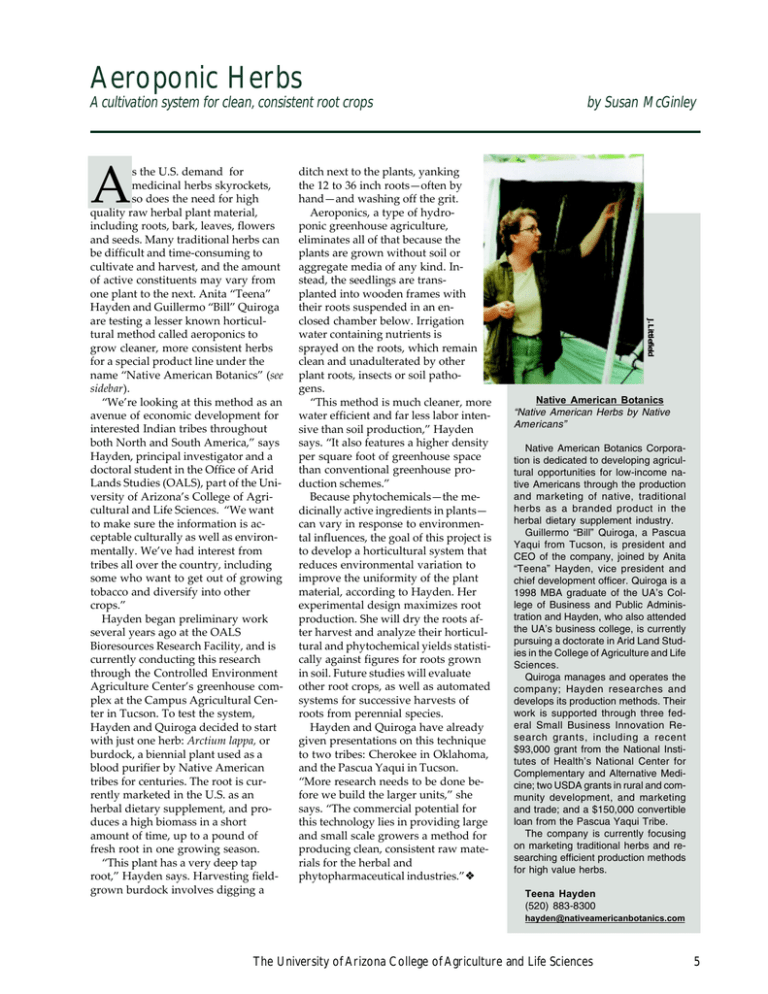A Aeroponic Herbs A cultivation system for clean, consistent root crops
advertisement

Aeroponic Herbs A cultivation system for clean, consistent root crops A ditch next to the plants, yanking the 12 to 36 inch roots—often by hand—and washing off the grit. Aeroponics, a type of hydroponic greenhouse agriculture, eliminates all of that because the plants are grown without soil or aggregate media of any kind. Instead, the seedlings are transplanted into wooden frames with their roots suspended in an enclosed chamber below. Irrigation water containing nutrients is sprayed on the roots, which remain clean and unadulterated by other plant roots, insects or soil pathogens. “This method is much cleaner, more water efficient and far less labor intensive than soil production,” Hayden says. “It also features a higher density per square foot of greenhouse space than conventional greenhouse production schemes.” Because phytochemicals—the medicinally active ingredients in plants— can vary in response to environmental influences, the goal of this project is to develop a horticultural system that reduces environmental variation to improve the uniformity of the plant material, according to Hayden. Her experimental design maximizes root production. She will dry the roots after harvest and analyze their horticultural and phytochemical yields statistically against figures for roots grown in soil. Future studies will evaluate other root crops, as well as automated systems for successive harvests of roots from perennial species. Hayden and Quiroga have already given presentations on this technique to two tribes: Cherokee in Oklahoma, and the Pascua Yaqui in Tucson. “More research needs to be done before we build the larger units,” she says. “The commercial potential for this technology lies in providing large and small scale growers a method for producing clean, consistent raw materials for the herbal and phytopharmaceutical industries.”❖ J. Littlefield s the U.S. demand for medicinal herbs skyrockets, so does the need for high quality raw herbal plant material, including roots, bark, leaves, flowers and seeds. Many traditional herbs can be difficult and time-consuming to cultivate and harvest, and the amount of active constituents may vary from one plant to the next. Anita “Teena” Hayden and Guillermo “Bill” Quiroga are testing a lesser known horticultural method called aeroponics to grow cleaner, more consistent herbs for a special product line under the name “Native American Botanics” (see sidebar). “We’re looking at this method as an avenue of economic development for interested Indian tribes throughout both North and South America,” says Hayden, principal investigator and a doctoral student in the Office of Arid Lands Studies (OALS), part of the University of Arizona’s College of Agricultural and Life Sciences. “We want to make sure the information is acceptable culturally as well as environmentally. We’ve had interest from tribes all over the country, including some who want to get out of growing tobacco and diversify into other crops.” Hayden began preliminary work several years ago at the OALS Bioresources Research Facility, and is currently conducting this research through the Controlled Environment Agriculture Center’s greenhouse complex at the Campus Agricultural Center in Tucson. To test the system, Hayden and Quiroga decided to start with just one herb: Arctium lappa, or burdock, a biennial plant used as a blood purifier by Native American tribes for centuries. The root is currently marketed in the U.S. as an herbal dietary supplement, and produces a high biomass in a short amount of time, up to a pound of fresh root in one growing season. “This plant has a very deep tap root,” Hayden says. Harvesting fieldgrown burdock involves digging a by Susan McGinley Native American Botanics “Native American Herbs by Native Americans” Native American Botanics Corporation is dedicated to developing agricultural opportunities for low-income native Americans through the production and marketing of native, traditional herbs as a branded product in the herbal dietary supplement industry. Guillermo “Bill” Quiroga, a Pascua Yaqui from Tucson, is president and CEO of the company, joined by Anita “Teena” Hayden, vice president and chief development officer. Quiroga is a 1998 MBA graduate of the UA’s College of Business and Public Administration and Hayden, who also attended the UA’s business college, is currently pursuing a doctorate in Arid Land Studies in the College of Agriculture and Life Sciences. Quiroga manages and operates the company; Hayden researches and develops its production methods. Their work is supported through three federal Small Business Innovation Research grants, including a recent $93,000 grant from the National Institutes of Health’s National Center for Complementary and Alternative Medicine; two USDA grants in rural and community development, and marketing and trade; and a $150,000 convertible loan from the Pascua Yaqui Tribe. The company is currently focusing on marketing traditional herbs and researching efficient production methods for high value herbs. Teena Hayden (520) 883-8300 hayden@nativeamericanbotanics.com The University of Arizona College of Agriculture and Life Sciences 5





